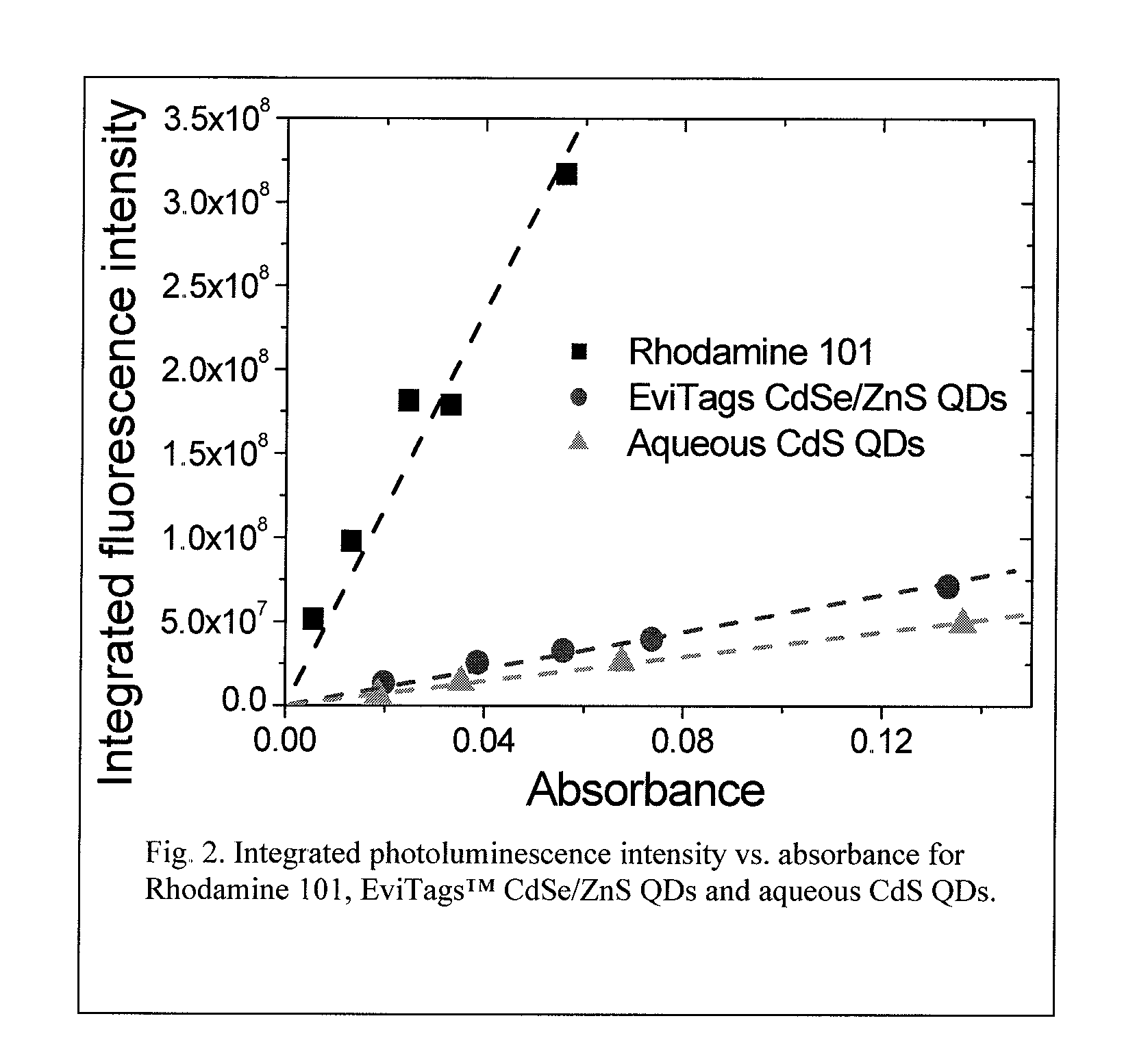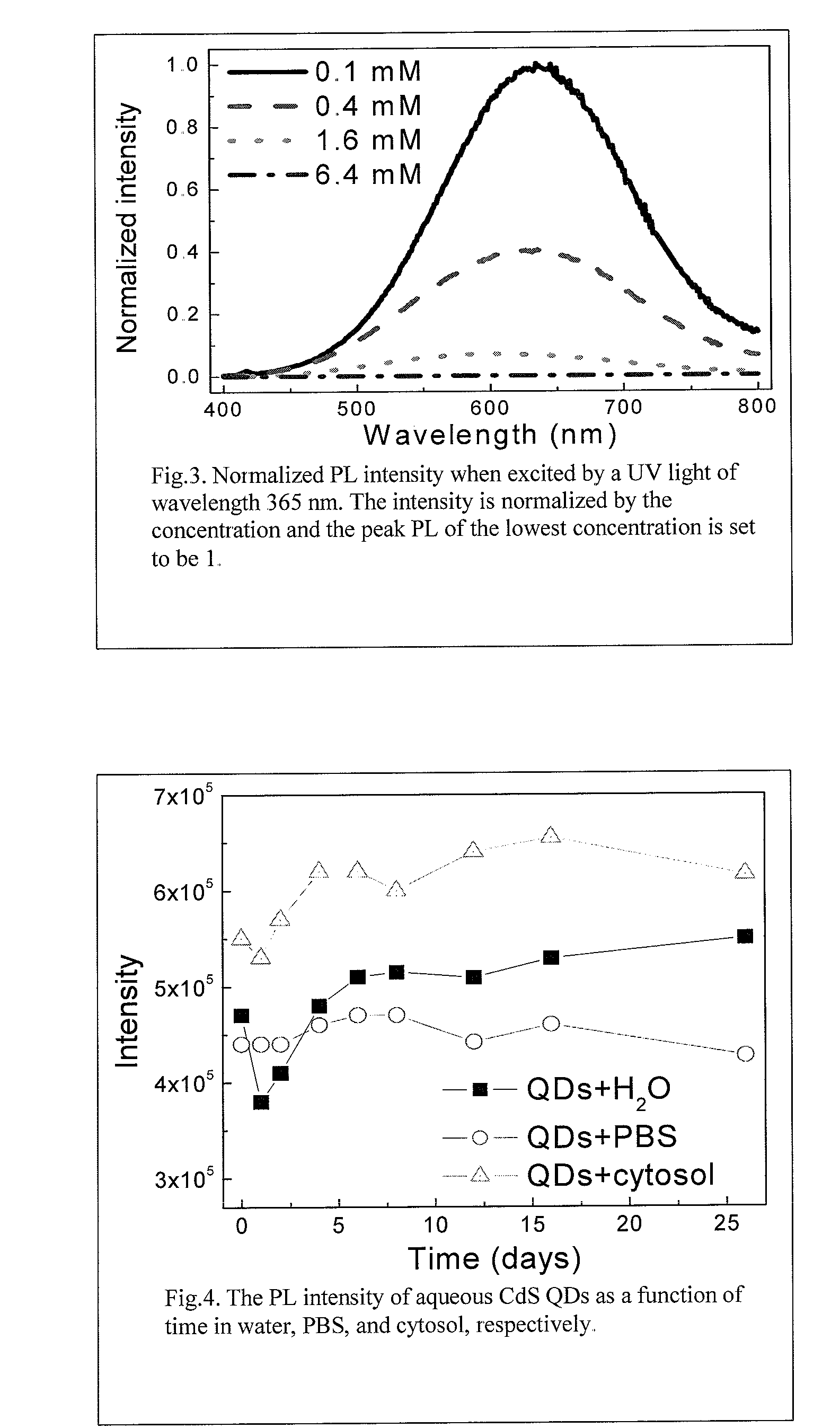Synthesis of water soluble non-toxic nanocrystalline quantum dots and uses thereof
a nanocrystalline, non-toxic technology, applied in the field of water-soluble non-toxic nanocrystalline quantum dots, can solve the problems of high cost, high complexity of the existing organic-based synthesis route for fabricating commercial qds, and always arises concerns about the use of radioactive materials in the body
- Summary
- Abstract
- Description
- Claims
- Application Information
AI Technical Summary
Problems solved by technology
Method used
Image
Examples
example i
Aqueous Synthesis of CdS QDs
[0058]1.6×10−4 mol Cd(NO3)2, 1.6×10−4 mol Na2S, and 3.2×10−4 mol MPA, respectively, were prepared and each was dissolved into about 33 ml deionized water with stirring. The Cd(NO3)2 solution was added to the MPA solution at 2 ml / min with continuous stirring. NH4OH (1 M) was added to the mixed solution to adjust the pH value to a pH of about 7-9. The Na2S solution was then quickly poured into the mixed solution and stirred for about 3-5 min. All of the above process steps were performed in an oxygen-free environment. In the present example, these steps were performed in a sealed glove bag pumped with nitrogen flow. An ultrasonicator was used to apply sonication for about 5-10 min. Large agglomerates were removed by filtration, as necessary. CdS nanoparticles were obtained in a clear suspension. The suspension was quenched in a freezer to 0° C., and the suspension was stored in a refrigerator at about 4° C.
example ii
Aqueous Synthesis of CdS QDs with ZnS Doping
[0059]0.8×10−4 mol Cd(NO3)2 and 0.8×10−4 mol Zn(NO3)2, respectively, were prepared and each dissolved into 16 ml deionized water with stirring. 1.6×10−4 mol Na2S and 3.2×10−4 mol MPA, respectively, were weighed and each dissolved into 33 ml deionized water with stirring. The Cd(NO3)2 solution was added into the MPA solution and then the Zn(NO3)2 solution was added into MPA solution at about 2 ml / min with continuous stirring. Thereafter, the process described in Example I was followed. The CdS with ZnS doping (1:1) QDs are obtained as a clear suspension. Other doping ratios can be employed by adjusting the Cd to Zn molar ratio.
Quantum Yield
[0060]To obtain the quantum yield of the aqueous CdS QDs, Rhodamine 101 was used as the standard sample, and the commercial QDs were compared. All the measurements were performed at the same conditions for Rhodamine 101, for the commercial EviTags™ CdSe / ZnS QDs and for the aqueous CdS QDs of the present i...
example iii
Synthesis and Characterization ZnS QDs with MPA
[0064]Aqueous ZnS QDs were synthesized at room temperature as follows. First, appropriate amounts of zinc nitrate (Zn(NO3)2), sodium sulfide (Na2S), and 3-mercaptopropionic acid (MPA) (Alfa Aesar, Ward Hill, Mass.) were dissolved in deionized (DI) water separately. For a MPA:Zn:S composition of 1:1:1, 0.08 mmol Zn(NO3)2 was first dropped slowly into the solution containing 0.08 mmol MPA with continuous stirring. Then the pH of the mixture was adjusted by adding the tetrapropylammonium hydroxide ((CH3CH2CH2)4NOH) (Alfa Aesar, Ward Hill, Mass.). After the desired pH was obtained, 0.08 mmol Na2S was added quickly with vigorous stirring to precipitate ZnS nanoparticles. 5 minutes was allowed for the precipitation to complete. If a higher Zn content was desired, the excess Zn was added after the initial precipitation, and the suspension was allowed to cure at room temperature for 5 more minutes. The final QDs suspension had a volume of 50 ml...
PUM
| Property | Measurement | Unit |
|---|---|---|
| Quantum yield | aaaaa | aaaaa |
| Quantum yield | aaaaa | aaaaa |
| Quantum yield | aaaaa | aaaaa |
Abstract
Description
Claims
Application Information
 Login to View More
Login to View More - R&D
- Intellectual Property
- Life Sciences
- Materials
- Tech Scout
- Unparalleled Data Quality
- Higher Quality Content
- 60% Fewer Hallucinations
Browse by: Latest US Patents, China's latest patents, Technical Efficacy Thesaurus, Application Domain, Technology Topic, Popular Technical Reports.
© 2025 PatSnap. All rights reserved.Legal|Privacy policy|Modern Slavery Act Transparency Statement|Sitemap|About US| Contact US: help@patsnap.com



